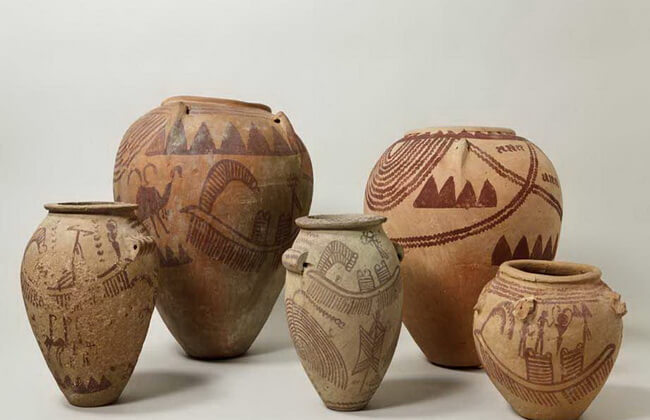Pottery in Ancient Egypt
From golden sarcophagi and intricate paintings, to new marvels uncovered beneath the blowing desert sands, a look at Egypt’s past reveals the work of incredible artisans and architects that lingers on, and amazes mankind to this day. Which makes it unsurprising to discover that the humble pottery of Egypt has a long and varied history as not only functional and food storage devices, but as time capsules that hold the literal hearts of some of history’s most well-known nobility.
The pottery of predynastic Egypt, notably in the Badarian period, was of an incredibly fine quality, and was made without the use of a pottery wheel. These items were then burnished until a sheen was achieved, before being fired, which resulted in a blackened top half, and darker red bottom. It is only from the Naqada period onwards that free-hand decorations were drawn onto the pottery, of daily life items like fishing, animals like crocodiles, and humans.
The clay used by artisans to craft their wares was only two specific types: Nile clay and Marl clay.
Nile Clay
Nile clay is also called in some circles as Nile silt ware or Nile mud clay due to its abundance along the Nile river. It is characterised by pottery that is predominantly of a reddish-brown colour – and this type of pottery remained unadorned in early periods, as it was used mainly for everyday purposes such as holding wine, oil, water or grain. The use of blue paint on this type of pottery only came about in the New Kingdom era.
Marl Clay
The other type of clay that was used to form pottery in ancient Egypt is Marl Clay which was gathered in the Qena area of Upper Egypt. It is considered by many to be far superior to the clay gathered along the Nile banks, and as such was used in different kinds of pottery such as decorative vases and ceremonial jars. This type of pottery received a high gloss treatment known as burnishing, though it must be noted that this isn’t the same thing as glazed pottery – which only appeared during Roman times.
Enamels
The art of covering pottery with various enamels before firing it, was something that Egyptian artisans became well-known for. Soapstone, or Steatite, has the ability to be worked and held into a high heat without cracking or shattering, which allowed many smaller trinkets, amulets, jewellery and the like to be enamelled in emerald greens, blues, reds and whites which became exceedingly brilliant once baked.
Motifs And Designs
Apart from showcasing hieroglyphics, motifs that mimic the appearance of basket weaves, wood and stone are quite commonly found on ancient pottery. These were created during the actual shaping of the pottery item before it was fired – either by hand shaping these designs or impressing them upon the malleable clay.
Finding pottery items in the shape of a variety of the gods or goddesses of ancient Egypt is also quite common – and some great examples of this which were found in ancient tombs are the canopic jars which were used to hold specific organs of the owner of the tomb.

